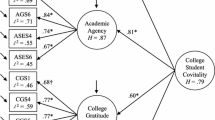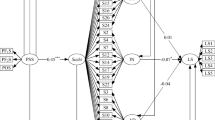Abstract
This study was an examination of the strength of relations among covitality, and its underlying constructs of belief in self, emotional competence, belief in others, and engaged living, and two outcome variables: subjective well-being and depression. Participants included 361 Australian secondary school students (75 males and 286 females) who completed a series of online questionnaires related to positive psychological well-being in adolescents. The results from the first standard multiple regression analysis indicated that higher levels of belief in self, belief in others, and engaged living were significant predictors of increased subjective well-being. The results from the second standard multiple regression showed that higher levels of belief in self, belief in others, and engaged living were significant predictors of decreased feelings of depression. In both standard multiple regression models, the combined effect of the traits that comprise covitality was greater than the effect of each individual positive psychological trait.
Similar content being viewed by others

References
Allen, J. P., Insabella, G., Porter, M. R., Smith, F. D., Land, D., & Phillips, N. (2006). A social-interactional model of the development of depressive symptoms in adolescence. Journal of Consulting and Clinical Psychology, 74, 55–65. doi:10.1037/0022-006X.74.1.55.
Australian Bureau of Statistics. (2007). 4326.0—National survey of mental health and wellbeing: summary of results, 2007. Retrieved from www.abs.gov.au/ausstats/abs@.nsf/Latestproducts/4326.0Main%20Features32007?opendocument&tabname=Summary&prodno
Australian Bureau of Statistics. (2011). 2011 Census QuickStats: all people—usual residents. Retrieved from www.censusdata.abs.gov.au/census_services/getproduct/census/2011/quickstat/0
Bandura, A. (1986). Social foundations of thought and action. Englewood Cliffs: Prentice-Hall.
Bandura, A. (1997). Self-efficacy: the exercise of control. New York: W. H. Freeman.
Bandura, A., Pastorelli, C., Barbaranelli, C., & Caprara, G. V. (1999). Self-efficacy pathways to childhood depression. Journal of Personality and Social Psychology, 76, 258–269.
Benson, P. L., Scales, P. C., Leffert, N., & Roehlkepartain, E. C. (1999). A fragile foundation: the state of developmental assets among American youth. Minneapolis: Search Institute.
Bono, G., Froh J. J., & Emmons, R. (2012). Searching for the developmental role of gratitude: a 4-year longitudinal analysis. Paper presented at the American Psychological Association’s 120th Annual Convention, Orange County, CA.
Cantor, N. (1990). From thought to behavior: “having” and “doing” in the study of personality and cognition. American Psychologist, 45, 735–750.
Caprara, G. V., Steca, P., Gerbino, M., Paciello, M., & Vecchio, G. (2006). Looking for adolescents’ well-being: self-efficacy beliefs as determinants of positive thinking and happiness. Epidemiologia e Psichiatria Sociale, 15, 30–43.
Carbonell, D. M., Reinherz, H. Z., & Giaconia, R. M. (1998). Risk and resilience in late adolescence. Child and Adolescent Social Work Journal, 15, 251–272.
Chester, C., Jones, D. J., Zalot, A., & Sterrett, E. (2007). The psychosocial adjustment of African American youth from single mother homes: the relative contribution of parents and peers. Journal of Clinical Child and Adolescent Psychology, 36, 356–366. doi:10.1080/15374410701444306.
Cicchetti, D., & Toth, S. L. (1998). Perspectives on research and practice in developmental psychopathology. In W. Damon (Ed.), Handbook of child psychology (5th ed., Vol. 4, pp. 479–583). New York: Wiley.
D'Acremont, M., & Van der Linden, M. (2007). How is impulsivity related to depression in adolescence? Evidence from a French validation of the Cognitive Emotion Regulation Questionnaire. Journal of Adolescence, 30, 271–282. doi:10.1016/j.adolescence.2006.02.007.
Dawes, N. P., & Larson, R. (2011). How youth get engaged: grounded-theory research on motivational development in organized youth programs. Developmental Psychology, 47, 259–269. doi:10.1037/a0020729.
Diener, E., Suh, E., Lucas, R., & Smith, H. (1999). Subjective well-being: three decades of progress. Psychological Bulletin, 125, 276–302.
Essau, C. A., & Chang, W. C. (2009). Epidemiology, comorbidity, and course of adolescent depression. In C. A. Essau (Ed.), Treatments for adolescent depression (pp. 3–25). Oxford: Oxford University Press.
Froh, J. J., Sefick, W. J., & Emmons, R. A. (2008). Counting blessings in early adolescents: an experimental study of gratitude and subjective well-being. Journal of School Psychology, 46, 213–233. doi:10.1016/j.jsp.2007.03.005.
Froh, J. J., Yurkewicz, C., & Kashdan, T. B. (2009). Gratitude and subjective well-being in early adolescence: examining gender differences. Journal of Adolescence, 32, 633–650. doi:10.1016/j.adolescence.2008.06.006.
Froh, J. J., Kashdan, T. B., Yurkewicz, C., Fan, J., Allen, J., & Glowacki, J. (2010). The benefits of passion and absorption in activities: engaged living in adolescents and its role in psychological wellbeing. The Journal of Positive Psychology, 5, 311–332. doi:10.1080/17439760.2010.498624.
Furlong, M. J., You, S., Renshaw, T., Smith, D. C., & O’Malley, M. D. (2014). Preliminary development and validation of the Social and Emotional Health Survey for secondary school students. Social Indicators Research, 117, 1011–1032. doi:10.1007/s11205-013-0373-0.
Gillham, J. E., Adams-Deutsch, Z., Werner, J., Reivich, K., Coulter-Heindl, V., Linkins, M., & Seligman, M. E. P. (2011). Character strengths predict subjective well-being during adolescence. The Journal of Positive Psychology, 6, 31–44. doi:10.1080/17439760.2010.536773
Ho, M. Y., Cheung, F. M., & Cheung, S. F. (2010). The role of meaning in life and optimism in promoting well-being. Personality and Individual Differences, 48, 658–666. doi:10.1016/j.paid.2010.01.008
Huebner, E. S. (1991). Initial development of the Students’ Life Satisfaction Scale. School Psychology International, 12, 231–243. doi:10.1177/0143034391123010.
Joiner, T. E., Lewinsohn, P. M., & Seeley, J. R. (2002). The core of loneliness: lack of pleasurable engagement—more so than painful disconnection—predicts social impairment, depression onset, and recovery from depressive disorders among adolescents. Journal of Personality Assessment, 79, 472–491. doi:10.1207/S15327752JPA7903_05.
Jones, C., You, S., & Furlong, M. J. (2012). A preliminary examination of co-vitality as integrated well-being in college students. Social Indicators Research, 111, 511–526. doi:10.1007/s11205-012-0017-9.
Jose, P. E., Ryan, N., & Pryor, J. (2012). Does social connectedness lead to a greater sense of well-being in adolescence? Journal of Research on Adolescence, 22, 235–251. doi:10.1111/j.1532-7795.2012.00783.x.
Kazdin, A. E., & Petti, T. A. (1982). Self-report and interview measures of childhood and adolescent depression. Journal of Child Psychology and Psychiatry, 23, 437–457.
Keyes, C. L. M. (2009). The nature and importance of positive mental health in America’s adolescents. In M. J. Furlong, R. Gilman, & E. S. Huebner (Eds.), Handbook of positive psychology in schools (pp. 9–23). New York: Routledge.
Lai, J. C. L. (2009). Dispositional optimism buffers the impact of daily hassles on mental health in Chinese adolescents. Personality and Individual Differences, 47, 247–249. doi:10.1016/j.paid.2009.03.007.
Laurent, J., Catanzaro, S. J., Joiner Jr., T. E., Rudolph, K. D., Potter, K. I., Lambert, S., Gathright, T. et al. (1999). A measure of positive and negative affect for children: scale development and preliminary validation. Psychological Assessment, 11, 326–338. doi:10.1037//1040-3590.11.3.326
Lee, S., You, S., & Furlong, M.J. (2015). Validation of the Social Emotional Health Survey—secondary for Korean students. Child Indicators Research. Published online, 24 January 2015. doi:10.1007/s12187-014-9294-y
Little, T. D., Snyder, C. R., & Wehmeyer, M. (2006). The agentic self: on the nature and origins of personal agency across the life span. In D. K. Mroczek & T. D. Little (Eds.), Handbook of personality development (pp. 61–79). Mahwah: Erlbaum.
Long, R. F., Huebner, E. S., Wedell, D. H., & Hills, K. J. (2012). Measuring school-related subjective wellbeing in adolescents. American Journal of Orthopsychiatry, 82, 50–60. doi:10.1111/j.1939-0025.2011.01130.x.
Loukas, A., Roalson, L. A., & Herrera, D. A. (2010). School connectedness buffers the effects of negative family relations and poor effortful control on early adolescent conduct problems. Journal of Research on Adolescence, 20, 13–22. doi:10.1111/j.1532-7795.2009.00632.x.
Maddux, J. E., & Meier, L. J. (1995). Self-efficacy and depression. In J. E. Maddux (Ed.), Self-efficacy, adaptation, and adjustment: theory, research and application (pp. 143–169). New York: Plenum.
Mwamwenda, T. S. (1995). Age differences in social desirability. Psychological Reports, 76, 825–826.
Myboot. (2011). Myboot: suburb profiles and crime statistics. Retrieved from http://myboot.com.au/
National Institute of Mental Health. (2013). Depression in children and adolescents. Retrieved from www.nimh.nih.gov/health/publications/depression-in-children-and-adolescents/index.shtml
Osterman, K. F. (2000). Students’ need for belonging in the school community. Review of Educational Research, 70, 323–367. doi:10.2307/1170786.
Pallant, J. F. (2011). SPSS Survival Manual: a step-by-step guide to data analysis using SPSS (4th ed.). Crows Nest: Allen & Unwin.
Park, N., & Peterson, C. (2006). Moral competence and character strengths among adolescents: the development and validation of the Values in Action Inventory of Strengths for Youth. Journal of Adolescence, 29, 891–909. doi:10.1016/j.adolescence.2006.04.011.
Patton, G. C., Tollit, M. M., Romaniuk, H., Spence, S. H., Sheffield, J., & Sawyer, M. G. (2011). A prospective study of the effects of optimism on adolescent health risks. Pediatrics, 127, 308–316. doi:10.1542/peds.2010-0748.
Radloff, L. S. (1977). The CES-D scale: a self-report depression scale for research in the general population. Applied Psychological Measurement, 1, 385–402.
Renshaw, T. L., Furlong, M. J., Dowdy, E., Rebelez, J., Smith, D. C., O’Malley, M. D., Lee, S. Y., & Strom, I. F. (2014). Covitality: a synergistic conception of adolescents’ mental health. In M. J. Furlong, R. Gilman, & E. S. Huebner (Eds.), Handbook of positive psychology in schools (2nd ed.). New York: Routledge/Taylor & Francis.
Resnick, M. D., Bearman, P. S., Blum, R. W., Bauman, K. E., Harris, K. M., Jones, J., Udry, J. R., et al. (1997). Protecting adolescents from harm: findings from the national longitudinal study of adolescent health. Journal of the American Medical Association, 278, 823–832.
Ronen, T., & Seeman, A. (2007). Subjective well being of adolescents in boarding schools under threat of war. Journal of Traumatic Stress, 20, 1053–1062. doi:10.1002/jts.20248.
Saarni, C., Campos, J., Camras, L., & Witherington, D. (2006). Emotional development: action, communication, and understanding. In N. Eisenberg (Ed.), Handbook of child psychology: Vol 3. Social, emotional, and personal development (6th ed., pp. 226–299). New York: Wiley.
Schmid, K. L., Phelps, E., Kiely, M. K., Napolitano, C. M., Boyd, M. J., & Lerner, R. M. (2011). The role of adolescents’ hopeful futures in predicting positive and negative developmental trajectories: findings from the 4-H Study of Positive Youth Development. The Journal of Positive Psychology, 6, 45–56. doi:10.1080/17439760.2010.536777.
Schoenbach, V. J., Kaplan, B. H., Wagner, E. H., Grimson, R. C., & Miller, F. T. (1983). Prevalence of self-reported depressive symptoms in young adolescents. American Journal of Public Health, 73, 1281–1287.
Seligman, M. E. P. (2005). Positive psychology, positive prevention, and positive therapy. In C. R. Snyder & S. J. Lopez (Eds.), Handbook of positive psychology (pp. 3–9). New York: Oxford University Press.
Shochet, I. M., Dadds, M. R., Ham, D., & Montague, R. (2006). School connectedness as an underemphasized parameter in adolescent mental health: results of a community prediction study. Journal of Clinical Child & Adolescent Psychology, 35, 170–179. doi:10.1207/s15374424jccp3502_1.
Sims, B. E., Nottelmann, E., Koretz, D., & Pearson, J. (2007). Prevention of depression in children and adolescents. American Journal of Preventive Medicine, 32, 451–455. doi:10.1016/j.amepre.2006.07.014.
SurveyMonkey. (2012). Online surveys by Zoomerang. Retrieved from http://www.zoomerang.com/
Watson, D., Clark, L. A., & Tellegen, A. (1988). Development and validation of brief measures of positive and negative affect: the PANAS scales. Journal of Personality and Social Psychology, 54, 1063–1070.
Wei, M., Liao, K. Y., Ku, T., & Shaffer, P. A. (2011). Attachment, self-compassion, empathy, and subjective well-being among college students and community adults. Journal of Personality, 79, 191–221. doi:10.1111/j.1467-6494.2010.00677.x.
Weiss, A., King, J. E., & Enns, R. M. (2002). Subjective well-being is heritable and genetically correlated with dominance in chimpanzees (Pan trogolodytes). Journal of Personality and Social Psychology, 83, 1141–1149. doi:10.1037/0022-3514.83.5.1141.
Wells, V. E., Klerman, G. L., & Deykin, E. Y. (1987). The prevalence of depressive symptoms in college students. Social Psychiatry, 22, 20–28.
World Health Organization (2013). Adolescent health. Retrieved from: www.who.int/topics/adolescent_health/en/
You, S., Dowdy, E., Furlong, M. J., Renshaw, T., Smith, D. C., & O’Malley, M. D. (2013). Further validation of the Social and Emotional Health Survey for high school students. Applied Research in Quality of Life. First published online December 2103. doi:10.1007/s11482-013-9282-2.
Zeman, J., Shipman, K., & Suveg, C. (2002). Anger and sadness regulation: predictions to internalizing and externalizing symptoms in children. Journal of Clinical Child and Adolescent Psychology, 31, 393–398.
Author information
Authors and Affiliations
Corresponding author
Rights and permissions
About this article
Cite this article
Pennell, C., Boman, P. & Mergler, A. Covitality Constructs as Predictors of Psychological Well-being and Depression for Secondary School Students. Contemp School Psychol 19, 276–285 (2015). https://doi.org/10.1007/s40688-015-0067-5
Published:
Issue Date:
DOI: https://doi.org/10.1007/s40688-015-0067-5



